Facebook Page Likes: A Marketing Research Article Analysis
VerifiedAdded on 2022/08/16
|7
|1761
|15
Report
AI Summary
This report provides an analysis of the research article "What Are Likes Worth? A Facebook Page Field Experiment" by Mochon et al. (2017). The study investigates the value of Facebook page likes for businesses, particularly focusing on how they influence offline customer behavior. The methodology involves randomizing a customer database and sending requests to like a page, measuring the impact on customer actions. The research found that a simple request to like a page can be effective in gaining likes and influencing customer activity. The article discusses the internal and external validity of the study, highlighting the methodology's strengths and limitations. Key findings include the effectiveness of Facebook likes in engaging new customers and the potential for posts to impact customer behavior. The report also explores the implications of these findings for marketing strategies, suggesting that businesses should manage their Facebook presence as they would traditional advertising tools. The analysis also references related research by Gneezy (2017), Gong et al. (2017), Lamberton & Stephen (2016), and Leung, Bai & Stahura (2015).
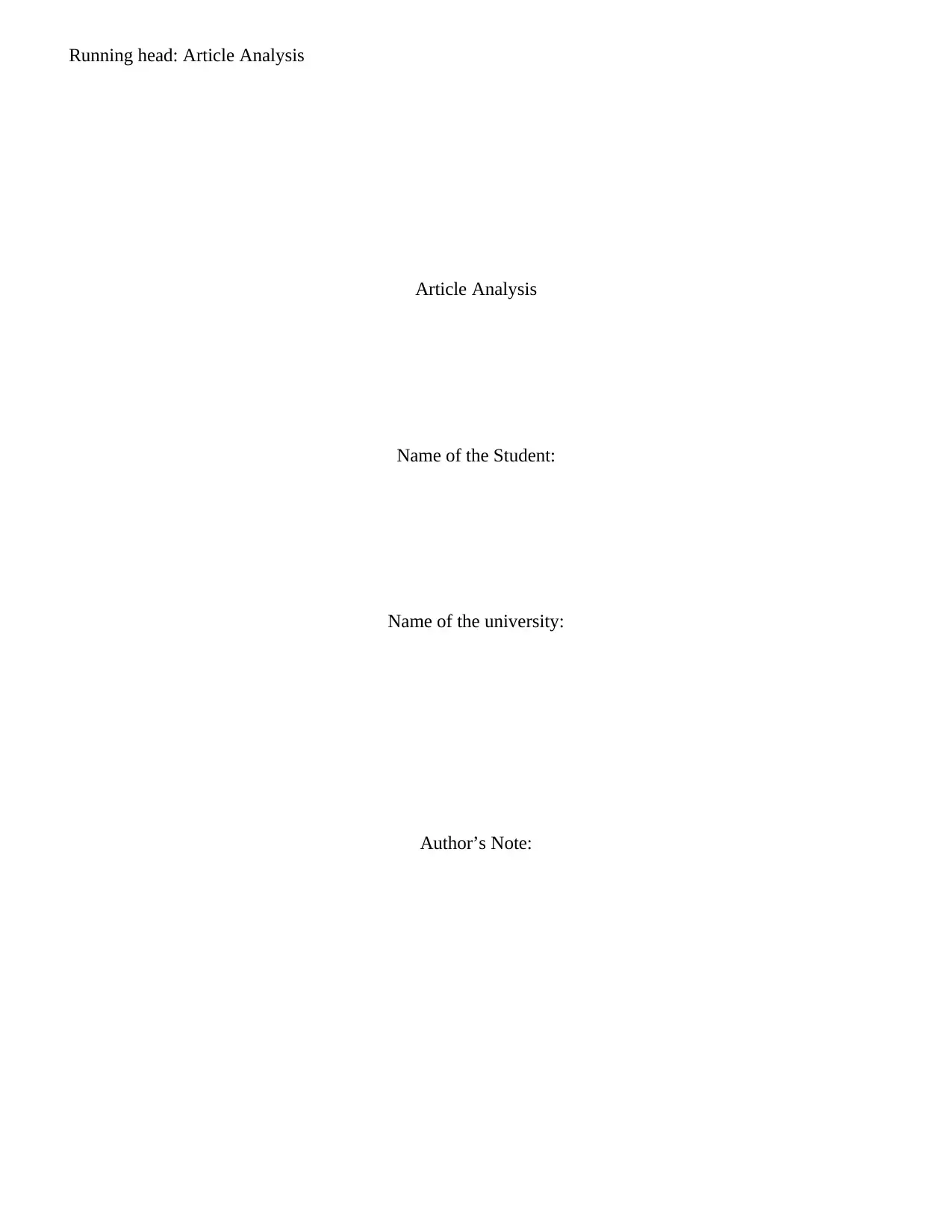
Running head: Article Analysis
Article Analysis
Name of the Student:
Name of the university:
Author’s Note:
Article Analysis
Name of the Student:
Name of the university:
Author’s Note:
Paraphrase This Document
Need a fresh take? Get an instant paraphrase of this document with our AI Paraphraser
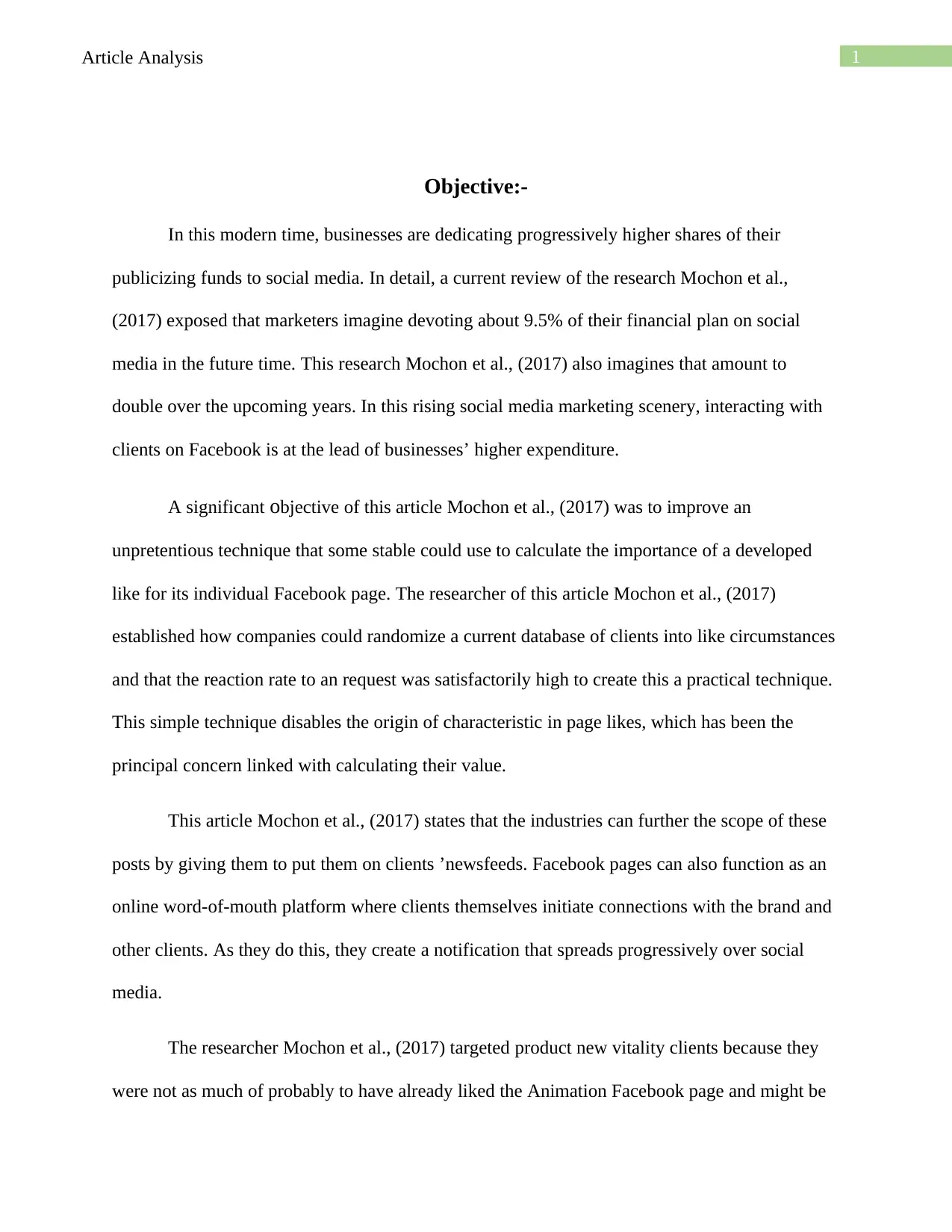
1Article Analysis
Objective:-
In this modern time, businesses are dedicating progressively higher shares of their
publicizing funds to social media. In detail, a current review of the research Mochon et al.,
(2017) exposed that marketers imagine devoting about 9.5% of their financial plan on social
media in the future time. This research Mochon et al., (2017) also imagines that amount to
double over the upcoming years. In this rising social media marketing scenery, interacting with
clients on Facebook is at the lead of businesses’ higher expenditure.
A significant objective of this article Mochon et al., (2017) was to improve an
unpretentious technique that some stable could use to calculate the importance of a developed
like for its individual Facebook page. The researcher of this article Mochon et al., (2017)
established how companies could randomize a current database of clients into like circumstances
and that the reaction rate to an request was satisfactorily high to create this a practical technique.
This simple technique disables the origin of characteristic in page likes, which has been the
principal concern linked with calculating their value.
This article Mochon et al., (2017) states that the industries can further the scope of these
posts by giving them to put them on clients ’newsfeeds. Facebook pages can also function as an
online word-of-mouth platform where clients themselves initiate connections with the brand and
other clients. As they do this, they create a notification that spreads progressively over social
media.
The researcher Mochon et al., (2017) targeted product new vitality clients because they
were not as much of probably to have already liked the Animation Facebook page and might be
Objective:-
In this modern time, businesses are dedicating progressively higher shares of their
publicizing funds to social media. In detail, a current review of the research Mochon et al.,
(2017) exposed that marketers imagine devoting about 9.5% of their financial plan on social
media in the future time. This research Mochon et al., (2017) also imagines that amount to
double over the upcoming years. In this rising social media marketing scenery, interacting with
clients on Facebook is at the lead of businesses’ higher expenditure.
A significant objective of this article Mochon et al., (2017) was to improve an
unpretentious technique that some stable could use to calculate the importance of a developed
like for its individual Facebook page. The researcher of this article Mochon et al., (2017)
established how companies could randomize a current database of clients into like circumstances
and that the reaction rate to an request was satisfactorily high to create this a practical technique.
This simple technique disables the origin of characteristic in page likes, which has been the
principal concern linked with calculating their value.
This article Mochon et al., (2017) states that the industries can further the scope of these
posts by giving them to put them on clients ’newsfeeds. Facebook pages can also function as an
online word-of-mouth platform where clients themselves initiate connections with the brand and
other clients. As they do this, they create a notification that spreads progressively over social
media.
The researcher Mochon et al., (2017) targeted product new vitality clients because they
were not as much of probably to have already liked the Animation Facebook page and might be
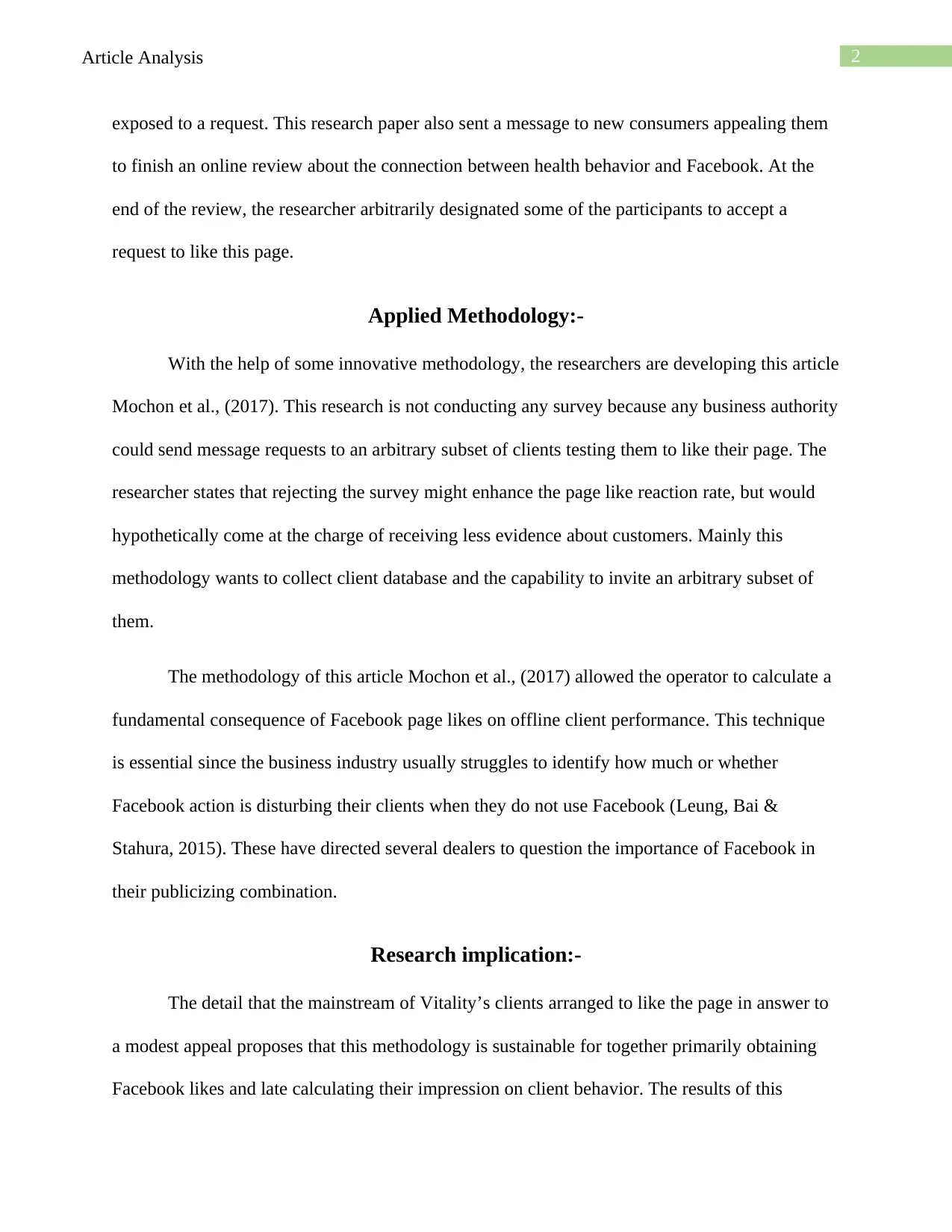
2Article Analysis
exposed to a request. This research paper also sent a message to new consumers appealing them
to finish an online review about the connection between health behavior and Facebook. At the
end of the review, the researcher arbitrarily designated some of the participants to accept a
request to like this page.
Applied Methodology:-
With the help of some innovative methodology, the researchers are developing this article
Mochon et al., (2017). This research is not conducting any survey because any business authority
could send message requests to an arbitrary subset of clients testing them to like their page. The
researcher states that rejecting the survey might enhance the page like reaction rate, but would
hypothetically come at the charge of receiving less evidence about customers. Mainly this
methodology wants to collect client database and the capability to invite an arbitrary subset of
them.
The methodology of this article Mochon et al., (2017) allowed the operator to calculate a
fundamental consequence of Facebook page likes on offline client performance. This technique
is essential since the business industry usually struggles to identify how much or whether
Facebook action is disturbing their clients when they do not use Facebook (Leung, Bai &
Stahura, 2015). These have directed several dealers to question the importance of Facebook in
their publicizing combination.
Research implication:-
The detail that the mainstream of Vitality’s clients arranged to like the page in answer to
a modest appeal proposes that this methodology is sustainable for together primarily obtaining
Facebook likes and late calculating their impression on client behavior. The results of this
exposed to a request. This research paper also sent a message to new consumers appealing them
to finish an online review about the connection between health behavior and Facebook. At the
end of the review, the researcher arbitrarily designated some of the participants to accept a
request to like this page.
Applied Methodology:-
With the help of some innovative methodology, the researchers are developing this article
Mochon et al., (2017). This research is not conducting any survey because any business authority
could send message requests to an arbitrary subset of clients testing them to like their page. The
researcher states that rejecting the survey might enhance the page like reaction rate, but would
hypothetically come at the charge of receiving less evidence about customers. Mainly this
methodology wants to collect client database and the capability to invite an arbitrary subset of
them.
The methodology of this article Mochon et al., (2017) allowed the operator to calculate a
fundamental consequence of Facebook page likes on offline client performance. This technique
is essential since the business industry usually struggles to identify how much or whether
Facebook action is disturbing their clients when they do not use Facebook (Leung, Bai &
Stahura, 2015). These have directed several dealers to question the importance of Facebook in
their publicizing combination.
Research implication:-
The detail that the mainstream of Vitality’s clients arranged to like the page in answer to
a modest appeal proposes that this methodology is sustainable for together primarily obtaining
Facebook likes and late calculating their impression on client behavior. The results of this
⊘ This is a preview!⊘
Do you want full access?
Subscribe today to unlock all pages.

Trusted by 1+ million students worldwide
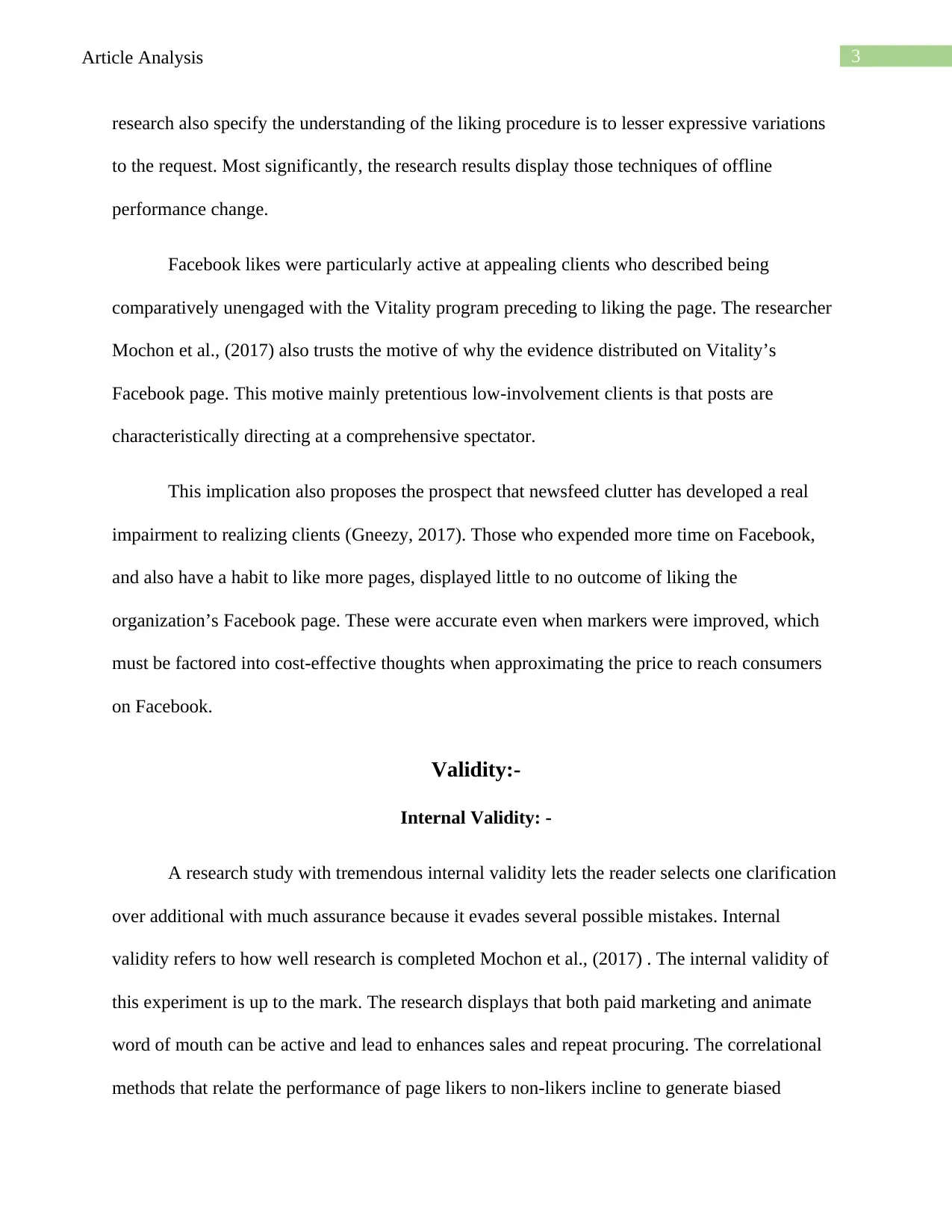
3Article Analysis
research also specify the understanding of the liking procedure is to lesser expressive variations
to the request. Most significantly, the research results display those techniques of offline
performance change.
Facebook likes were particularly active at appealing clients who described being
comparatively unengaged with the Vitality program preceding to liking the page. The researcher
Mochon et al., (2017) also trusts the motive of why the evidence distributed on Vitality’s
Facebook page. This motive mainly pretentious low-involvement clients is that posts are
characteristically directing at a comprehensive spectator.
This implication also proposes the prospect that newsfeed clutter has developed a real
impairment to realizing clients (Gneezy, 2017). Those who expended more time on Facebook,
and also have a habit to like more pages, displayed little to no outcome of liking the
organization’s Facebook page. These were accurate even when markers were improved, which
must be factored into cost-effective thoughts when approximating the price to reach consumers
on Facebook.
Validity:-
Internal Validity: -
A research study with tremendous internal validity lets the reader selects one clarification
over additional with much assurance because it evades several possible mistakes. Internal
validity refers to how well research is completed Mochon et al., (2017) . The internal validity of
this experiment is up to the mark. The research displays that both paid marketing and animate
word of mouth can be active and lead to enhances sales and repeat procuring. The correlational
methods that relate the performance of page likers to non-likers incline to generate biased
research also specify the understanding of the liking procedure is to lesser expressive variations
to the request. Most significantly, the research results display those techniques of offline
performance change.
Facebook likes were particularly active at appealing clients who described being
comparatively unengaged with the Vitality program preceding to liking the page. The researcher
Mochon et al., (2017) also trusts the motive of why the evidence distributed on Vitality’s
Facebook page. This motive mainly pretentious low-involvement clients is that posts are
characteristically directing at a comprehensive spectator.
This implication also proposes the prospect that newsfeed clutter has developed a real
impairment to realizing clients (Gneezy, 2017). Those who expended more time on Facebook,
and also have a habit to like more pages, displayed little to no outcome of liking the
organization’s Facebook page. These were accurate even when markers were improved, which
must be factored into cost-effective thoughts when approximating the price to reach consumers
on Facebook.
Validity:-
Internal Validity: -
A research study with tremendous internal validity lets the reader selects one clarification
over additional with much assurance because it evades several possible mistakes. Internal
validity refers to how well research is completed Mochon et al., (2017) . The internal validity of
this experiment is up to the mark. The research displays that both paid marketing and animate
word of mouth can be active and lead to enhances sales and repeat procuring. The correlational
methods that relate the performance of page likers to non-likers incline to generate biased
Paraphrase This Document
Need a fresh take? Get an instant paraphrase of this document with our AI Paraphraser
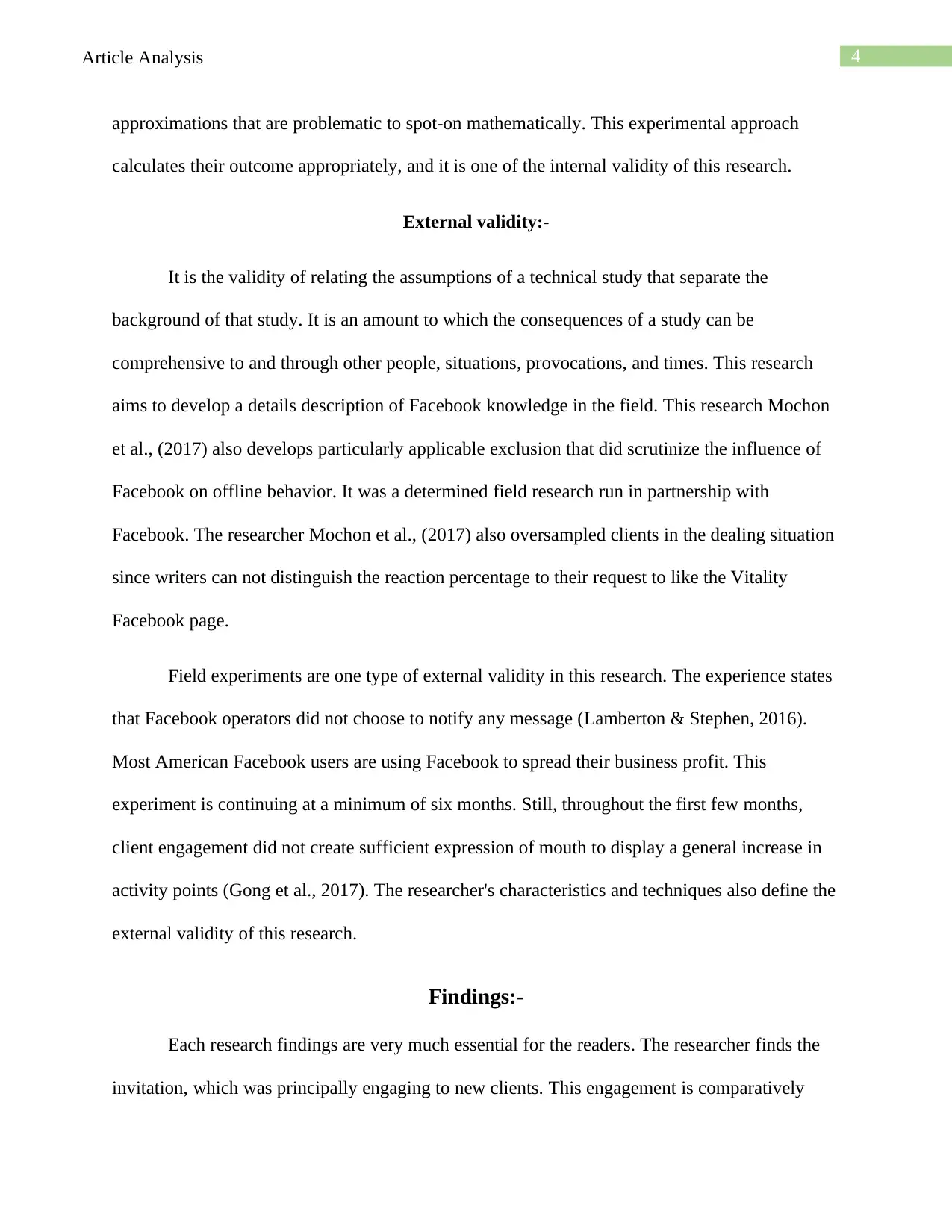
4Article Analysis
approximations that are problematic to spot-on mathematically. This experimental approach
calculates their outcome appropriately, and it is one of the internal validity of this research.
External validity:-
It is the validity of relating the assumptions of a technical study that separate the
background of that study. It is an amount to which the consequences of a study can be
comprehensive to and through other people, situations, provocations, and times. This research
aims to develop a details description of Facebook knowledge in the field. This research Mochon
et al., (2017) also develops particularly applicable exclusion that did scrutinize the influence of
Facebook on offline behavior. It was a determined field research run in partnership with
Facebook. The researcher Mochon et al., (2017) also oversampled clients in the dealing situation
since writers can not distinguish the reaction percentage to their request to like the Vitality
Facebook page.
Field experiments are one type of external validity in this research. The experience states
that Facebook operators did not choose to notify any message (Lamberton & Stephen, 2016).
Most American Facebook users are using Facebook to spread their business profit. This
experiment is continuing at a minimum of six months. Still, throughout the first few months,
client engagement did not create sufficient expression of mouth to display a general increase in
activity points (Gong et al., 2017). The researcher's characteristics and techniques also define the
external validity of this research.
Findings:-
Each research findings are very much essential for the readers. The researcher finds the
invitation, which was principally engaging to new clients. This engagement is comparatively
approximations that are problematic to spot-on mathematically. This experimental approach
calculates their outcome appropriately, and it is one of the internal validity of this research.
External validity:-
It is the validity of relating the assumptions of a technical study that separate the
background of that study. It is an amount to which the consequences of a study can be
comprehensive to and through other people, situations, provocations, and times. This research
aims to develop a details description of Facebook knowledge in the field. This research Mochon
et al., (2017) also develops particularly applicable exclusion that did scrutinize the influence of
Facebook on offline behavior. It was a determined field research run in partnership with
Facebook. The researcher Mochon et al., (2017) also oversampled clients in the dealing situation
since writers can not distinguish the reaction percentage to their request to like the Vitality
Facebook page.
Field experiments are one type of external validity in this research. The experience states
that Facebook operators did not choose to notify any message (Lamberton & Stephen, 2016).
Most American Facebook users are using Facebook to spread their business profit. This
experiment is continuing at a minimum of six months. Still, throughout the first few months,
client engagement did not create sufficient expression of mouth to display a general increase in
activity points (Gong et al., 2017). The researcher's characteristics and techniques also define the
external validity of this research.
Findings:-
Each research findings are very much essential for the readers. The researcher finds the
invitation, which was principally engaging to new clients. This engagement is comparatively
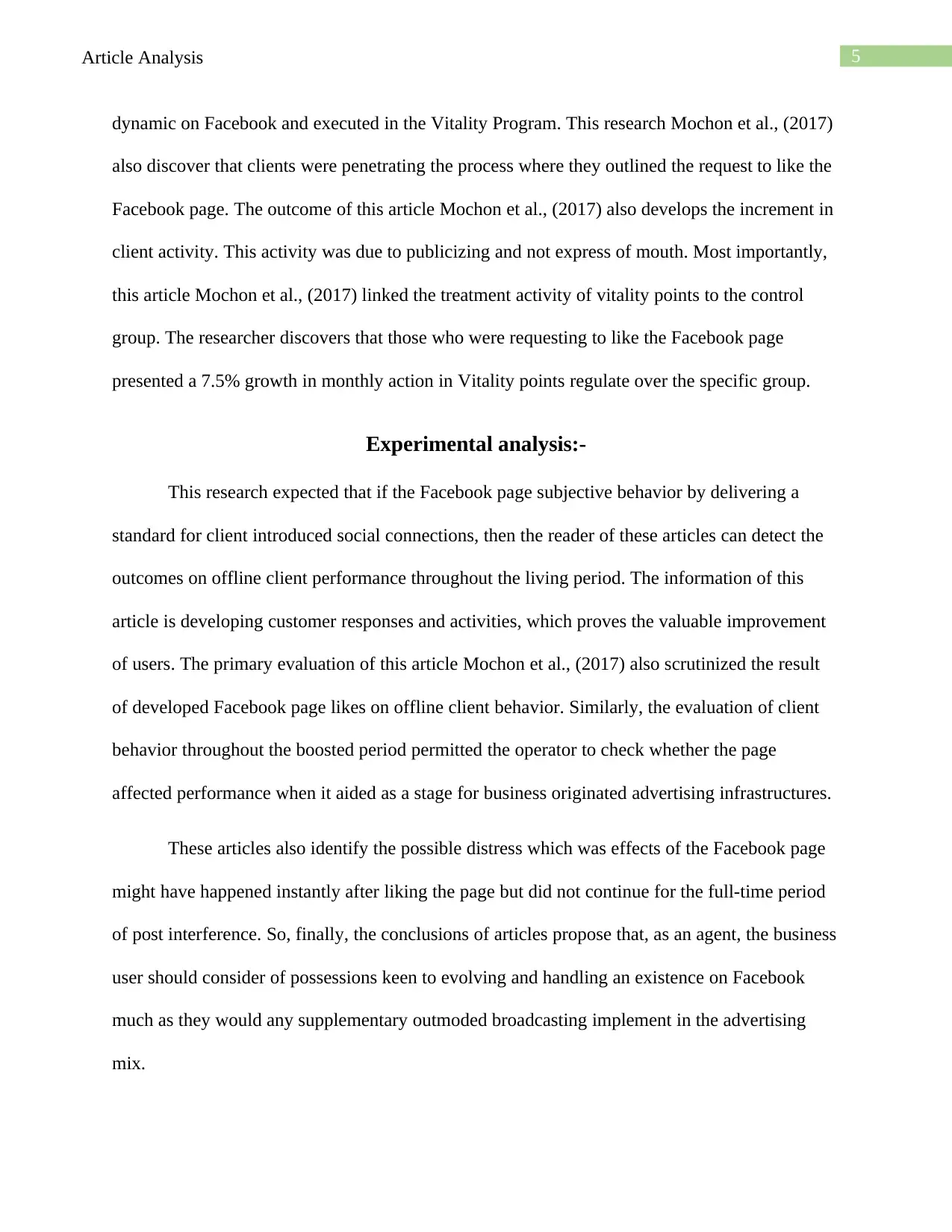
5Article Analysis
dynamic on Facebook and executed in the Vitality Program. This research Mochon et al., (2017)
also discover that clients were penetrating the process where they outlined the request to like the
Facebook page. The outcome of this article Mochon et al., (2017) also develops the increment in
client activity. This activity was due to publicizing and not express of mouth. Most importantly,
this article Mochon et al., (2017) linked the treatment activity of vitality points to the control
group. The researcher discovers that those who were requesting to like the Facebook page
presented a 7.5% growth in monthly action in Vitality points regulate over the specific group.
Experimental analysis:-
This research expected that if the Facebook page subjective behavior by delivering a
standard for client introduced social connections, then the reader of these articles can detect the
outcomes on offline client performance throughout the living period. The information of this
article is developing customer responses and activities, which proves the valuable improvement
of users. The primary evaluation of this article Mochon et al., (2017) also scrutinized the result
of developed Facebook page likes on offline client behavior. Similarly, the evaluation of client
behavior throughout the boosted period permitted the operator to check whether the page
affected performance when it aided as a stage for business originated advertising infrastructures.
These articles also identify the possible distress which was effects of the Facebook page
might have happened instantly after liking the page but did not continue for the full-time period
of post interference. So, finally, the conclusions of articles propose that, as an agent, the business
user should consider of possessions keen to evolving and handling an existence on Facebook
much as they would any supplementary outmoded broadcasting implement in the advertising
mix.
dynamic on Facebook and executed in the Vitality Program. This research Mochon et al., (2017)
also discover that clients were penetrating the process where they outlined the request to like the
Facebook page. The outcome of this article Mochon et al., (2017) also develops the increment in
client activity. This activity was due to publicizing and not express of mouth. Most importantly,
this article Mochon et al., (2017) linked the treatment activity of vitality points to the control
group. The researcher discovers that those who were requesting to like the Facebook page
presented a 7.5% growth in monthly action in Vitality points regulate over the specific group.
Experimental analysis:-
This research expected that if the Facebook page subjective behavior by delivering a
standard for client introduced social connections, then the reader of these articles can detect the
outcomes on offline client performance throughout the living period. The information of this
article is developing customer responses and activities, which proves the valuable improvement
of users. The primary evaluation of this article Mochon et al., (2017) also scrutinized the result
of developed Facebook page likes on offline client behavior. Similarly, the evaluation of client
behavior throughout the boosted period permitted the operator to check whether the page
affected performance when it aided as a stage for business originated advertising infrastructures.
These articles also identify the possible distress which was effects of the Facebook page
might have happened instantly after liking the page but did not continue for the full-time period
of post interference. So, finally, the conclusions of articles propose that, as an agent, the business
user should consider of possessions keen to evolving and handling an existence on Facebook
much as they would any supplementary outmoded broadcasting implement in the advertising
mix.
⊘ This is a preview!⊘
Do you want full access?
Subscribe today to unlock all pages.

Trusted by 1+ million students worldwide
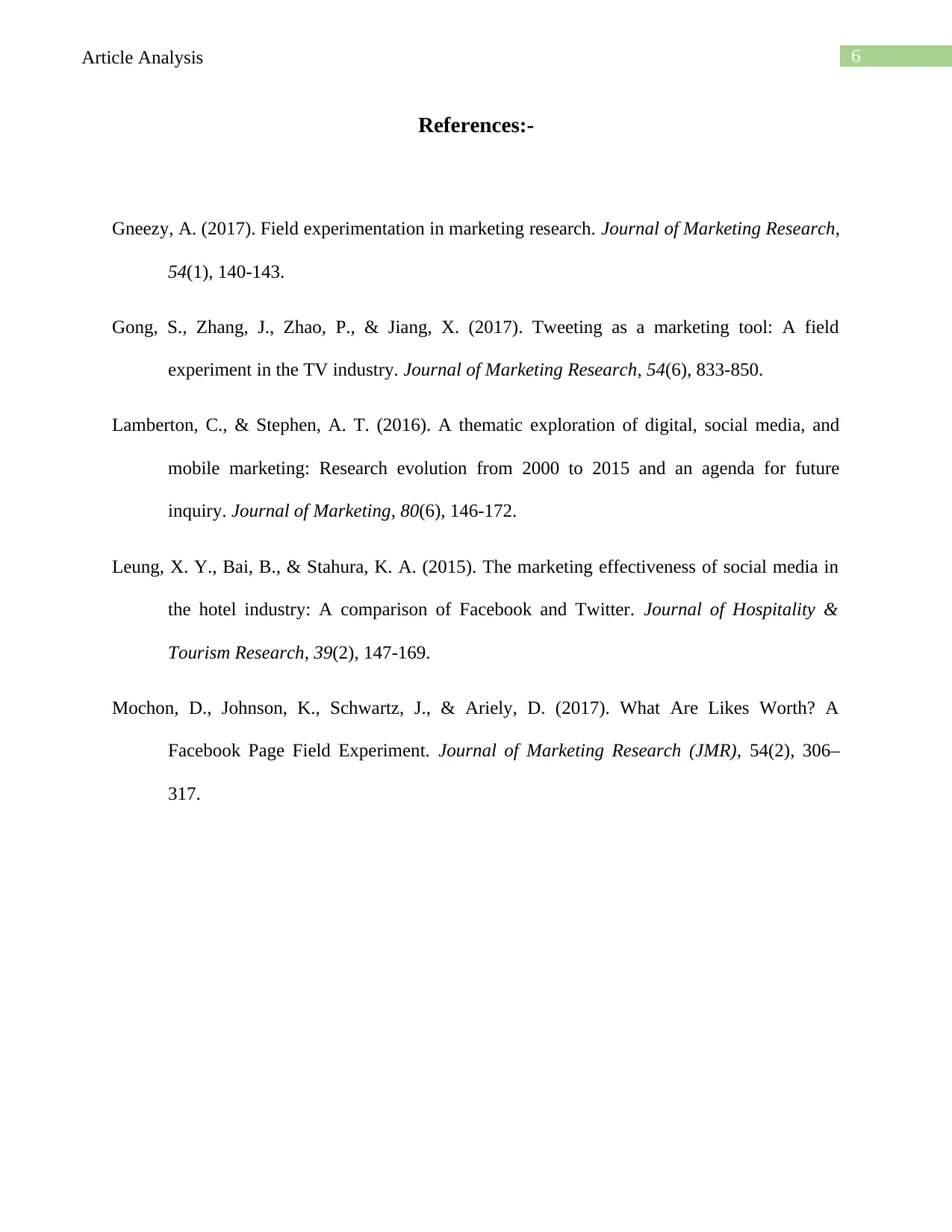
6Article Analysis
References:-
Gneezy, A. (2017). Field experimentation in marketing research. Journal of Marketing Research,
54(1), 140-143.
Gong, S., Zhang, J., Zhao, P., & Jiang, X. (2017). Tweeting as a marketing tool: A field
experiment in the TV industry. Journal of Marketing Research, 54(6), 833-850.
Lamberton, C., & Stephen, A. T. (2016). A thematic exploration of digital, social media, and
mobile marketing: Research evolution from 2000 to 2015 and an agenda for future
inquiry. Journal of Marketing, 80(6), 146-172.
Leung, X. Y., Bai, B., & Stahura, K. A. (2015). The marketing effectiveness of social media in
the hotel industry: A comparison of Facebook and Twitter. Journal of Hospitality &
Tourism Research, 39(2), 147-169.
Mochon, D., Johnson, K., Schwartz, J., & Ariely, D. (2017). What Are Likes Worth? A
Facebook Page Field Experiment. Journal of Marketing Research (JMR), 54(2), 306–
317.
References:-
Gneezy, A. (2017). Field experimentation in marketing research. Journal of Marketing Research,
54(1), 140-143.
Gong, S., Zhang, J., Zhao, P., & Jiang, X. (2017). Tweeting as a marketing tool: A field
experiment in the TV industry. Journal of Marketing Research, 54(6), 833-850.
Lamberton, C., & Stephen, A. T. (2016). A thematic exploration of digital, social media, and
mobile marketing: Research evolution from 2000 to 2015 and an agenda for future
inquiry. Journal of Marketing, 80(6), 146-172.
Leung, X. Y., Bai, B., & Stahura, K. A. (2015). The marketing effectiveness of social media in
the hotel industry: A comparison of Facebook and Twitter. Journal of Hospitality &
Tourism Research, 39(2), 147-169.
Mochon, D., Johnson, K., Schwartz, J., & Ariely, D. (2017). What Are Likes Worth? A
Facebook Page Field Experiment. Journal of Marketing Research (JMR), 54(2), 306–
317.
1 out of 7
Related Documents
Your All-in-One AI-Powered Toolkit for Academic Success.
+13062052269
info@desklib.com
Available 24*7 on WhatsApp / Email
![[object Object]](/_next/static/media/star-bottom.7253800d.svg)
Unlock your academic potential
Copyright © 2020–2025 A2Z Services. All Rights Reserved. Developed and managed by ZUCOL.





